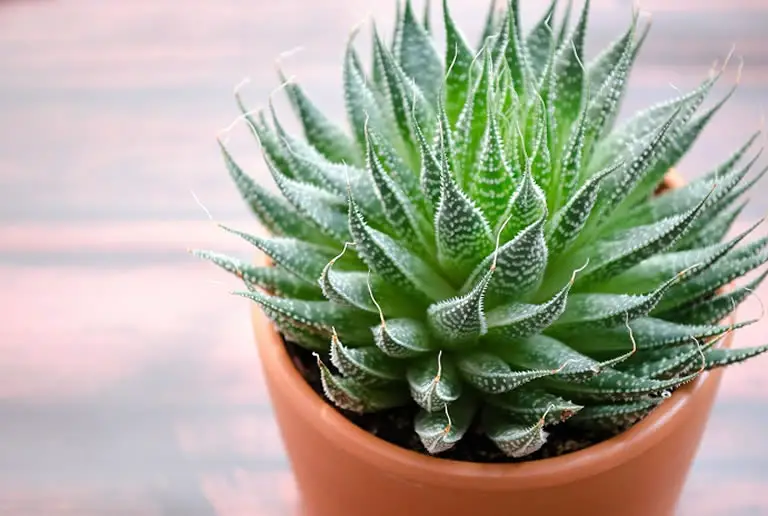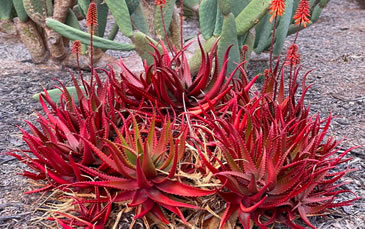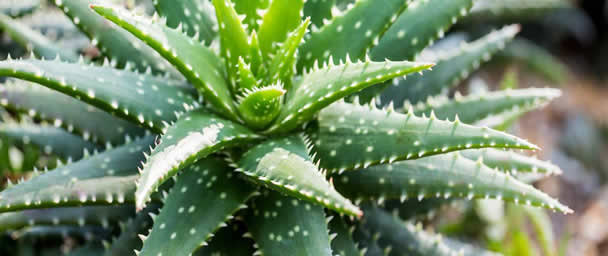Aloe Plants Are Succulents With Special Care Needs

With over 500 different types of aloe species in the world these plants are popular as both indoor decorative houseplants and as outdoor garden plants. Aloe plants are easy to care for when you know how to treat them.
Knowledge of your aloe plant is essentially if you want it to be healthy and produce beautiful foliage. This knowledge starts by knowing if the aloe plant is a succulent or not.
Table of Contents [hide]
Aloe plants are succulents
Aloe plants are succulents. With the correct care they can thrive as indoor plants but can also be grown outdoors but only in the correct climate.
Aloe succulent plants are not difficult to grow nor are they difficult to care for.
You do require a certain degree of knowledge about the proper care practices for aloe though as these plants require a different type of care than other types of common garden or houseplants.
The different types of aloe succulents
There are 550 different species of aloe plant in the world. The 20 most common aloe plants can be seen in both outdoor gardens and in indoor pots.
The most commonly known aloe succulent is the Aloe Vera which is not only used as an outdoor plant and houseplant for decoration but is regularly used in skin care products as well. But Aloe Vera isn’t the only common aloe plant found in gardens and houses.
There are many other types of aloe plant and although they do share common characteristics they can vary quite dramatically in looks.
Most Aloe plant species will have large and thick leaves that spread out from the center of the plant in a rosette formation.
However, there are also aloe succulent plants that have a spiral formation and these succulents look quite dramatic indoors and outdoors.
Most aloe plants will produce tubular shaped flowers in a range of colors from pink and orange to yellow and red (see our aloe bloom guide).
Some aloe plants have stems while others will appear to have no stem with the rosette of leaves growing at ground level.
Just as the flowers of different succulents can vary in color so too can the leaves.
Leaves on aloe succulents can range from a bright green to dull grey with a range of colors in-between> the leaves can also be mottled with spots and smears or be striped in appearance.

Succulents naturally grow in warm dry climates and are often referred to as desert plants.
They therefore require very little maintenance but do require very careful care in order to avoid damaging the plant. See our aloe plant care article.
Having said that aloe succulents are not difficult to look after and require very little attention like many plants that are used in a dry climate.
You just need to be aware their watering cycles.
A guide to successfully planting & growing aloe succulents
Aloe plants naturally grow in tropical climates. They are native to tropical deserts in Africa, Madagascar, Jordan, the Arabian Peninsula and various islands in the Indian Ocean such as Réunion, Mauritius and Comoros.
They will thrive outdoors only in similar climatic environments but will just as happily grow in desert rocks and sandy soil.
They also work very well as an indoor plant.
Let’s look at how to plant these succulents in an outdoor garden and how to pot them for indoor decoration.
Planting aloe plants outdoors is only possible in some locations
As aloe plants are succulents you can only grow them outdoors if you live in a warm climate. Succulents do not react well to cold weather.
Freezing temperatures will not only kill the leaves and the stems that are above ground but freezing soil will completely kill the roots and thus kill your plant.
See our climate zone guide to see if your location is suitable for growing aloe succulent plants outdoors.
If you have the correct local climate for aloe succulents then be sure to choose a spot that has well drained soil.
If need be, create a raised and/or sloped bed to allow for adequate water drainage, from rainfall, as the soil for succulents needs to dry out completely between waterings.
You may want to plant your aloe succulents in a succulent potting mix to give them the best change of thriving and to also offset any disadvantages your local soil may have as far as succulents go.
You can plant aloe in desert rock or sand if you live in the right place
As a desert plant, aloe succulents will grow really well in desert rock or sandy soil.
The following information relates to planting your aloe succulent in a pot but the same information applies to planting it in the ground.
To start the planting process combine equal parts of coarse sand, perlite and succulent potting soil together to form a desert potting mix. Place the mix in an outdoor terracotta plant pot with adequate drainage holes.
Once you have filled the pot with the soil mixture, water it lightly until you see water coming from the drainage holes at the bottom of the pot. Do not attempt to plant your aloe succulent until the water has fully drained from the pot and no more drops are coming from the drainage holes.
Once the soil is ready for planting dig a thin hole in the soil mix deep enough that it matches the length of your aloe plant roots. When you plant the succulent it should be at the same depth it was in its original container or the ground from which it came.
Then place a thin layer of small pebbles or small rocks on the soil surface and spread them out evenly as they will act as a natural mulch.
Place your new potted aloe succulent somewhere that receives a good amount of sunlight and that is warm. Obviously, if you are planting the succulent directly into the ground you will need to be very selective about the planting location before you begin the process.
With a potted plant though you simply need to move the plant from one location to another if you find that it is not receiving enough sunlight with the changing seasons.
The care requirements of an aloe succulent plant that is rooted in desert rock or sand is the same as one that is planted in different soil types. For more information on aloe soil type and for details about the best pot to use read this article.
The information given below covers everything you need to know to grow a healthy aloe plant.
Growing potting aloe plants indoors is better in most locations
Aloe is a great indoor plant for those who tend to forget to water their plants. Those with a busy lifestyle, or who spend regular time away from home, find aloe succulents to be a fantastically easy to care-for indoor plant.
As a succulent an aloe plant does not require daily watering and can go much longer without water than other popular types of indoor plant. In fact, it needs to go without water for long periods to thrive!
Aloe plants do not react well to over-watering so keep your house plant in a pot with a good amount of drainage holes.
A good quality terracotta pot with drainage holes and a water tray will work the best for all succulents as it dries quicker than other container types and this type of pot also helps to highlight, the colors of the plant.
Make sure the soil is not compacted too tightly so that water easily flows through the layers and out the drainage holes. You don’t want water to gather in the soil and remain damp.You can use a mixture of equal parts sand and potting soil or simply buy a specially prepared succulent mix.
Any good quality succulent mix designed for a dry climate plant, such as cacti or citrus, will work really well for aloe plants.
Caring for aloe succulents is fairly simple
Caring for aloe plants is very easy and takes very little work. However, some knowledge of how to care for these succulents is essential.
For example, watering an aloe succulent with the same watering routine you use for other non-succulent plants will likely drown your succulent.

Outdoor aloe plant care
Outdoor succulents, like aloe plants, that are planted in the correct soil, and in the correct climate, need almost no care. This means you do not need to water your outdoor succulents. The only exception to this rule is when there is a sever drought that lasts 8 weeks or more.
In the case of prolonged drought, when the soil is completely dried out and your plant is starting to show signs of water deprivation (limp or shriveled leaves), then you should give the plant a complete and thorough soaking until the soil is fully wet.
Allow the soil to fully dry out fully before even thinking about watering the plant again even if the drought continues. If it starts to rain normally, leave the watering can alone!
Indoor potted aloe plants are easier to care for
Whether you are growing from seed, stem or have bought a mature aloe plant be sure to place it in a bright spot in your house. Aloe succulents thrive best in a sunny place. A lack of sunlight will cause your aloe plant to go dormant and it will stop growing.
Unlike most other houseplants that require regular watering an aloe succulent plant can, and should, go long periods without being watered. These plants are native to dry areas that go long spells without rain and are only watered by short bouts of infrequent heavy rainfall.
So, allow your aloe succulent soil to dry out fully before you water it. This usually takes about two weeks in normal apartment or house temperatures but may vary depending on the time of year and your location.
When the soil has dried out water the plant heavily once only.
Aloe succulents plants are are a desert species and so do not react well to damp soil. If you over-water the plant, by keeping the soil wet continually, the roots of your plant will rot. Read our guide to aloe vera root rot and causes and treatment.
If you are unsure about your watering routine look for limp or brown leaves as this is a clear sign of overwatering. If the leaves are shrinking and shriveled then you have went too long without watering the plant.
For a newbie to succulents start off with a watering routine of watering heavily once every two weeks until you start to become familiar with your plant.
Potted aloe succulents can be placed outdoors in warm summer months but you need to gradually introduce the plant to direct sunlight or you risk over exposure.
Move it closer to a spot with continual direct sunlight over a period of about 6 days, moving it closer every other day.
Although aloe plants grow very well in small containers and tight spaces a well cared-for succulent may outgrow its pot. When the weight of the plant causes your pot to fall over it’s time to repot it into a bigger container.
How to fertilize an aloe plant to help it thrive
Aloe plants require very little fertilization. If you do want to fertilize your plant only do it once in the spring months and then again, only once, in the summer months.
Use a well balanced houseplant formula mixed at about ½ strength or you can use a specially formulated succulent fertilizer for both your indoor and outdoor aloe plants.
Thanks for reading! I'm Michael — houseplant fanatic and your Pinterest plant guide.
Follow me on Pinterest for fresh updates 🌿



